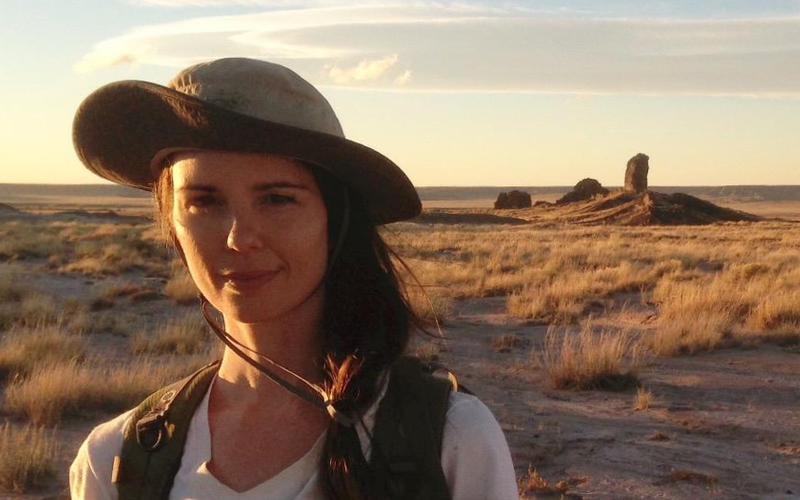Q&A: Monitoring Volcanic Eruptions Using Lightning
Originally a journalism major, Alexa Van Eaton never intended to study volcanoes, much less investigate the link between eruptions and the lightning that can accompany them. But she got hooked on these earth-shaping events after an introductory geology class on the formation of the Solar System and the history of life on Earth. Specifically, her attention was caught by the prospect of using clues from rocks and landforms to explain the processes that formed the world around us.
Van Eaton’s calling as a volcanologist led her to the United States Geological Survey’s Cascades Volcano Observatory in Vancouver, Washington. There she collaborates with the World Wide Lightning Location Network (WWLLN)—a collection of radio antennas that detect and pinpoint the location of radio waves produced by lightning. WWLLN was created to study atmospheric phenomena, but in 2008, it sounded alerts at a location that corresponded to a major eruption of Chile’s Chaiten volcano. Those alerts prompted researchers to develop the WWLLN volcanic lightning monitor, a tool that reports lightning detected near active volcanoes. In a conversation with Physics, Van Eaton discusses the challenges in measuring volcanic lightning and the community efforts to use lightning for near-real-time observations of hazardous explosions.
–Rachel Berkowitz
When did scientists first document volcanic lightning, and why is doing so still a challenge?
In 79 A.D., Pliny the Younger documented lightning from the eruption of Mt Vesuvius in Italy—the same eruption that destroyed Pompeii and Herculaneum. More recently, in 1963, researchers photographed and measured electrical activity in the ash plumes from a volcano off the coast of Iceland, whose submarine eruption formed a new island called Surtsey. But the science of volcanic lightning is still young. The challenge with these measurements is being in the right place at the right time and with the right instrumentation to gather data.
What causes volcanic lightning?
Volcanic lightning forms within the ash plume that bursts into the atmosphere during an eruption. Ash particles scrape, collide, and steal electrons from each other, generating a static charge. Colliding ice particles can also cause electrification, if the plume rises high enough to freeze. Convective circulation and particle fallout then separate the different-sized particles, building an electric field that triggers lightning. Lightning can occur during any explosive eruption, but more powerful eruptions tend to have more lightning. An evolving conceptual model is that electrification of ash occurs in all plumes. But additional electrification from ice particles strengthens the electric field, leading to higher rates of detectable lightning.
Ice charging implies water is present; where does that water come from?
Volcanoes erupt explosively because of water in the magma. When magma rises toward the surface, the pressure release turns water in the magma into vapor, which then expands violently and blasts outward. Water can also enter an eruption when magma intersects a lake, ocean, glacier, aquifer, or hydrothermal system. These eruptions inject more vapor into the atmosphere, resulting in increased ice production.
How might lightning help in monitoring explosive eruptions?
Most volcanoes have limited monitoring as they are located in remote terrain or in an ocean. Lighning provides an alternative tool to ground-based geophysical sensors—the bread and butter of volcano monitoring tools—for detecting hazardous eruptions.
How so?
Lightning can start seconds to minutes after an ash plume bursts into the atmosphere. Each lightning discharge emits a broad spectrum of electromagnetic energy. Radio-wave lightning emissions, so-called sferics, are detectable from halfway around the planet. And because electromagnetic radiation propagates faster than sound waves or seismic waves, lightning can be the first sign of an eruption. But for lightning to become a useful volcano-monitoring tool, we need more details on how and where its electrical discharges originate. Those details would allow us to identify the timing and severity of an eruption from lightning data.
What fascinates you about volcanic lightning?
Most of my research focuses on eruptions from the ancient geological record. There are no videos of those events, so scientists tease out the details of how eruptions unfolded using clues from the layers of ash they left behind. It’s forensic science for volcanism. For recent eruptions, drone videos and volcanic lightning detection offer a wide range of data and illuminate fine-scale movement of ash and water through the volcanic plume. It’s really exciting to use this data to apply a fresh perspective to past eruptions as I try to understand how those eruptions influenced ancient landscapes and communities.
Any advice for students who want to see if volcanology is for them?
Volcanology merges many science fields. If you’re interested, your best bet is to contact a volcanologist and ask them how to get involved. People are usually happy to give advice or point to other experts. Twitter is a great way to connect with scientists—feel free to reach out to me @volcaniclastic or the volcano community at large @USGSVolcanoes, and ask us your questions.
Rachel Berkowitz is a Corresponding Editor for Physics based in Seattle, Washington, and Vancouver, Canada.
Know a physicist with a knack for explaining their research to others? Write to physics@aps.org. All interviews are edited for brevity and clarity.





